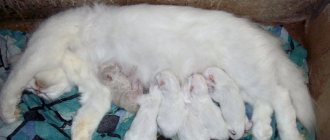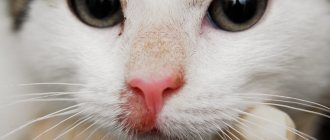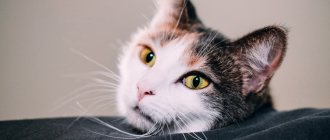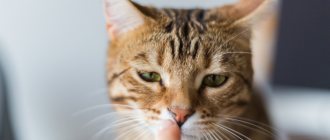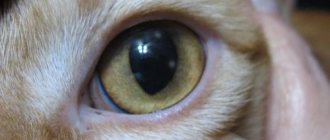Paul Gray, bass guitarist and one of the founders of the popular band Slipknot, said about cats this way: “They, by their very existence, refute the statement that everything in the world was created for man.” These wayward animals have long become full members of families. And although cats love independence, sometimes they may need help from their owner. Visual acuity is very important in a cat's life, and keratitis affects the eyes. But what to do if a serious illness appears and how to prevent blindness in your pet?
1) What is keratitis 2) Reasons for the development of keratitis in cats 3) Symptoms and consequences of the disease 4) Forms and types of keratitis 5) Diagnosis of keratitis 6) Treatment of keratitis in adults 7) Treatment of keratitis in kittens Preventive measures
Preventive measures
What is keratitis
Inflammation of the cornea, or keratitis, is a very common eye disease. A characteristic feature of keratitis in cats is clouding of the cornea, the appearance of ulcers and discharge from the diseased eye. Breeds that are predisposed to the disease include the Siamese, American Smooth-haired, British and Sphynx. The latter is due to the absence of eyelashes and the presence of a large number of folds pressing on the eyelids. The owner needs to pay attention to the cat’s appearance so as not to miss the first signs of poor health.
Establishing diagnosis
To determine the cause of the pathology, an examination of the eyeball is performed. It is possible to establish the true cause of the pathology through a comprehensive examination, which includes:
- taking anamnesis;
- use of fluorescein;
- tonometry;
- ophthalmoscopy;
- serological, biochemical and general blood tests;
- cytology or microscopy;
- smear culture;
- examination of intraocular fluid samples;
- Ultrasound of the eyeball;
- gonioscopy.
Anamnesis collection includes information about the animal’s contacts, menu composition, the presence of concurrent diseases and methods of their treatment. To determine the presence of ulcers, the cornea is stained with a fluorescent substance.
Main symptoms
When the cat gets sick, it shows nervousness and increased excitability. However, based on the cause of its appearance, parallel signs characteristic of a specific pathology are observed. There are three degrees of damage.
- Peripheral degree - present as a border, on the edges of the apple.
- The central lesion is the very center of the organ of vision.
- Total degree - the eye is completely closed.
At the same time, the cat’s behavior changes. Due to decreased vision, the pet walks unsteadily and does not see obstacles in the form of furniture or other objects. Nervousness and increased excitability appear. Strabismus can often be observed. In the presence of inflammation, there is pain, discharge, and swelling of the mucous membrane.
Causes of keratitis in cats
More often, this disease is acquired rather than congenital, and occurs due to infections or mechanical impacts on the cornea (sand, dust, branches, hard objects, etc.), as well as:
- allergic reactions; — chemical or thermal burns of the eyes; - blockage and/or inflammation of the lacrimal glands, resulting in drying out of the conjunctiva and cornea (keratitis can develop in parallel with conjunctivitis - inflammation of the mucous membrane of the eyelid - since it fits tightly to the cornea during blinking); — vitamin deficiency; — infections and viruses (herpes, calcivirosis, adenovirus, chlamydia, etc.); - autoimmune diseases.
“Murkoshi” employees recommend examining cats’ vision organs more often to prevent the development of the disease.
Diagnostics
Diagnosis of herpetic keratitis begins with examination. The presence of characteristic blisters suggests a lesion caused by herpes. Since the disease can be sluggish, without characteristic manifestations, the diagnosis is clarified using laboratory and instrumental studies. To detect the pathogen, scrapings are taken from the affected tissues or tear fluid.
Laboratory diagnosis of ophthalmoherpes includes:
- Study of scrapings from the conjunctiva using fluorescent antibodies.
- Linked immunosorbent assay.
- Blood or tear fluid test for antiherpetic antibodies.
- Polymerase chain reaction (PCR) of biological fluids that detects the virus.
Instrumental examination helps to assess the extent and depth of anatomical changes. Instrumental diagnostics include anterior optical coherence tomography, biomicroscopy and fluorescein test.
A fluorescein test is performed to identify ulcers or films on the cornea and assess the area and extent of the lesion. After applying the solution to the eye, the ophthalmologist examines the tissue using a slit lamp with a blue filter.
Symptoms and consequences of the disease
Depending on the causes of its appearance, the disease can develop within a few hours and occur in acute or chronic form. Knowing the symptoms of keratitis development, the owner will be able to seek help from a veterinarian in time. With keratitis in a cat, the following is observed:
- inflammation of the eyelids (blepharitis); — intolerance to sunlight and artificial light (photophobia); - squinting of the affected eye (blepharospasm); - accumulation of infiltrate inside the cornea (fluid), causing the eye to swell; — clouding of the cornea (it becomes matte, in contrast to a healthy shiny one); - the appearance of blood vessels on the cornea; - discharge from the inflamed eye and pus in the corners (the fur under the eye will be damp).
The animal also develops itching, which causes it to scratch the eye with its paws, which leads to inflammation of the eyelids. If treatment for keratitis in a cat or kitten is started late or performed incorrectly, this can lead to the following consequences:
- the appearance of a thorn (a cloudy spot on the eye); - development of cataracts or glaucoma; - corneal breakthrough; - the appearance of scars (in this case, further treatment is useless, the moment is missed - the cat will go blind).
Glaucoma
Glaucoma is an eye disease in cats that develops against the background of increased intraocular pressure. The cornea loses transparency during an acute attack of the disease.
Optic nerve atrophy leads to complete blindness of the animal within 2-4 days after the attack. Therefore, the animal needs urgent veterinary care.
Symptoms of an acute attack of glaucoma:
- pain when touching the eye;
- photophobia;
- corneal edema;
- high intraocular pressure.
Treatment for an acute attack of glaucoma involves urgently reducing the pressure inside the eye. Manipulations must be carried out by a veterinary specialist with monitoring of the animal’s condition.
Further treatment consists of the use of drugs that reduce intraocular pressure, diuretics and agents that help stabilize the cat's condition.
Forms and types of keratitis
Keratitis in cats has several forms:
1. Viral. Most often caused by an adenovirus or herpes virus. When it occurs, the integrity of the cornea is compromised, and as the disease develops, deeper layers are also affected.
Read more about herpes: Treatment of herpes in cats
2. Allergic. Develops as a result of improper administration of medications or an allergy to a vaccine. It causes redness, tearing and swelling.
3. Bacterial. Develops due to bacteria entering the organ of vision after injury. It occurs acutely, with severe purulent complications.
4. Neurogenic, or ulcerative. It is caused by damage to nervous tissue as a result of diabetes mellitus, chronic renal failure, and hypovitaminosis. With this form, ulcers appear in the cat's eye, but she does not experience pain. The disease goes away on its own if there is no secondary infection.
5. Eosinophilic. Occurs when blood enters the cornea. Most often, this form becomes chronic. Frequent relapses are possible.
The disease also varies in severity:
— purulent superficial (inflammation of the upper layer of the cornea); — deep purulent (inflammation of all layers of the cornea); - vascular superficial (capillaries grow into the upper layer of the cornea).
Risk factors
The causes of keratitis are known, and there are also risk factors that significantly increase the likelihood of developing the disease.
Immediate causes include:
- Infections, parasitic infestations.
- Mechanical injuries, chemical, thermal damage.
- Allergy.
These causes lead to the occurrence of infectious (for example, herpetic), traumatic or allergic keratitis, respectively.
Among the risk factors for developing the disease, the following are most important:
- Presence of autoimmune diseases.
- Long-term wearing of contact lenses.
- Dry eye syndrome.
- Lack of vitamins.
- Various metabolic disorders.
- The presence of some systemic diseases: diabetes, gout, rheumatism.
Based on the list of risk factors, it is clear that keratitis is a fairly common pathology.
Treatment of keratitis in adults
American actress Deborah Edwards once said: “The only people who don’t like cats are those who haven’t met their cat yet.” It is impossible not to love furry friends, as well as to watch their poor health with peace of mind. However, when treating keratitis in a cat, the owner must keep in mind that the cause of the disease is eliminated in the first place. Antimicrobial and hormonal drugs, of course, will work, but, with a greater degree of probability, keratitis will return. We at Murkosh categorically do not recommend self-medication - there is a risk of harming your pet.
Treatment of keratitis requires an integrated approach. So, for fungal, bacterial and viral forms, antifungal and antibacterial drugs are prescribed, respectively. And also interferon-containing. In case of complications, sulfonamide drugs and antibiotics are prescribed. For ulcerative and purulent cases, eye drops and antiseptics are instilled into the conjunctival sac. The animal is prescribed antibiotics, and if ulcers or neoplasms are found, eye microsurgery is performed. Using an antiseptic solution helps a lot:
— 3% boric acid; - 1% rivanol; - furatsilin in a ratio of 1:5000.
The eosinophilic form of keratitis in cats requires immunomodulatory and anti-inflammatory drugs. The following may also be prescribed:
1. "Dekta-2". Eye drops for the treatment of keratitis, blepharitis, allergic conjunctivitis. The cost is about 170 rubles for 5 ml.
2. "Bars". Eye drops with anti-inflammatory, antibacterial and anesthetic properties. They are used to treat acute and chronic forms of conjunctivitis, keratitis, blepharitis, and injuries to the organs of vision. The cost is about 200 rubles for 10 ml.
3. "Ophthalmosan". Eye drops for the prevention and treatment of keratitis, blepharitis, allergic conjunctivitis and other bacterial diseases. The cost is about 250 rubles for 15 ml.
Therapy methods
Treatment at home is carried out as prescribed by a veterinarian.
For infectious pathologies, antibiotics are used, and antibacterial agents can be used.
Identified corneal ulcers and glaucoma require surgical intervention. Often, for glaucoma, complete removal of the eye is performed.
Excision of corneal ulcers is a less painful procedure. During this procedure, only the affected tissue is removed. After the procedure, scars remain that prevent full restoration of vision.
Therapy is carried out using non-steroidal anti-inflammatory drugs. The drugs have an impressive list of contraindications and, with prolonged treatment, can negatively affect the general condition of the animal .
For any pathologies, it is recommended for the cat to drip antiseptic drugs and apply medicinal ointments. At the same time, the affected organ is moisturized.
With timely treatment, it is possible to prevent the penetration of pathogenic microorganisms.
The cat needs to create comfortable conditions. He needs rest and diet.
Sometimes complex therapy is used:
- use of Gamavit and Tetracycline ointment;
- washing the organ with Metrogyl solution;
- use of drugs containing Actovegin;
- prescription of antiviral drugs.
Traditional methods of treatment
Traditional medicine should be used carefully. It is advisable to consult a veterinarian before starting therapy.
The following remedies will help alleviate your pet's condition:
- Tea. 1 tbsp is poured into a glass. dry tea leaves, pour boiling water. Use after completely cooled.
- Elder. To prepare the medicine, 1 tsp. elderberries are poured with boiling water (0.5 cups). Let the liquid infuse for about an hour and filter.
- Celandine. Five leaves pour 2 tbsp. boiling water The liquid is infused for half an hour, then filtered.
- Calendula: 2 tbsp. raw materials are poured with a glass of boiling water, left for a quarter of an hour, filtered.
- Aloe. Three leaves are crushed in a blender, the juice is filtered using gauze.
Medicines are used as follows:
- moisten a cotton pad in the liquid and move it from the outer corner to the inner one;
- change the cotton pad after each wipe;
- both eyelids are treated.
Preventive measures
It is better to prevent any disease than to treat it. Keratitis in cats is no exception. To prevent illness in pets:
— Keep the house clean, wipe off the dust. — The animal’s diet must be balanced. The best choice is professional super-premium and holistic-class food. — “Murkoshi” volunteers recommend getting vaccinated in a timely manner. Vaccinations will help protect your pet's body from infection. - Brush the cat. Lost hair can get into the eye, rub the cornea and conjunctiva, leading to inflammation. — Do not keep open chemicals within the cat’s reach to avoid burns. — Strengthen your animal’s immunity with vitamins. Remember to deworm.
Read more about deworming: Preparations for deworming cats
— Examine your pet’s eyes, especially if there is watery eyes. Mechanical irritation of the cornea is possible. — If the animal has a predisposition to keratitis, eye examinations should be performed more often.
The danger of keratitis for a kitten or cat cannot be underestimated. But, at the same time, it is possible to cure the disease by noticing deviations in the animal’s well-being and unhealthy eye conditions in time and contacting a veterinarian.
conclusions
Constant observation and control is the key to successful treatment. If you notice the slightest sign of deterioration - increasing areas of redness, pain or a sharp increase in discharge - immediately contact a veterinarian.
Observation by a veterinarian and monitoring the cat’s condition is the key to successful treatment.
